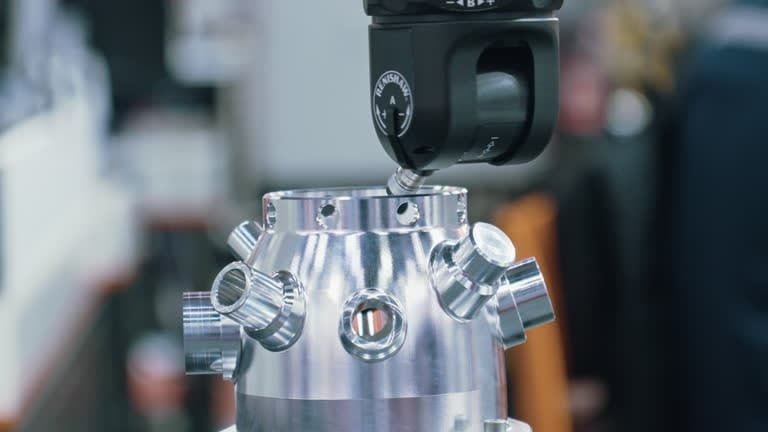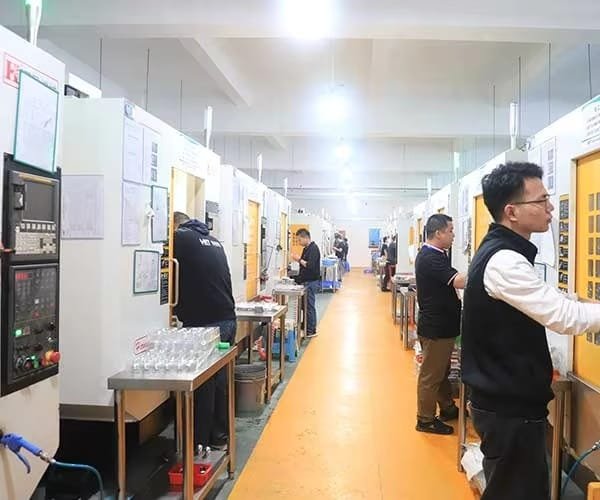Introduction
While CNC (Computer Numerical Control) machining transformed multiple industries, its influence on the medical sector shows exceptional significance. Computer-guided tools that shape raw materials into precise components now serve as the foundational manufacturing process for high-quality medical devices and surgical equipment. CNC machining represents a revolutionary advancement because its unparalleled accuracy and adaptability deliver essential precision in fields where mistakes can result in life-altering consequences.

The medical production industry demands precise operations down to micrometer measurements and resilient materials capable of withstanding bodily conditions and sterilization processes while its manufacturing procedures need to serve mass production requirements and personal patient specifications. CNC medical machining services surpasses established requirements and becomes vital for modern healthcare technology. This article explores how CNC machining serves diverse medical industry purposes by analyzing its operational process and the medical devices it creates together with the materials used and technological developments that drive its evolution and future trends.
The Role of CNC Machining in the Medical Industry

By tackling some of the most urgent problems used in the medical sector—precision, repeatability, customizing, and speed—CNC machining has found a home in the medical field. The basic causes of the great value this technology offers are investigated in this part.
1. High Precision and Accuracy
Precision represents an essential requirement within the medical machining field where high accuracy is mandatory. Every medical component from pacemaker screws to hip implant shapes demands precise manufacturing according to exact specifications. CNC machines demonstrate their strength in precision by achieving tolerances of ±0.001 inches which is approximately 0.0254 millimeters. The precision provided at this level ensures that components fit perfectly together while operating correctly and maintaining patient safety. A surgical tool that deviates even slightly from its specifications may fail during use while an implant misaligned with a patient’s anatomy could cause discomfort or rejection. CNC machining removes risk through its dependable precision which manual techniques cannot replicate.
2. Consistency in Mass Production
Medical equipment manufacturing needs vast numbers of identical parts including the thousands of forceps hospitals use globally and the millions of screws found in orthopedic kits. Manual machining requires skill but creates inconsistent results which reduces quality throughout production. CNC machining utilizes pre-programmed instructions to fabricate identical components repeatedly in large batches. Manufacturers who need to comply with strict regulatory requirements depend on consistency while healthcare providers need tools that deliver reliable performance in every use. Medical device manufacturing and suppliers depend on CNC machining because it allows them to expand production while maintaining top-notch quality standards.
3. Customization for Patient-Specific Needs
The ability to adapt CNC machining processes to meet unique patient requirements stands out as one of its most thrilling features. The development of 3D scanning and CAD technologies has enabled personalized medicine to reach new levels of possibility. A patient who requires a cranial plate after surgery can receive their personalized implant through the process of skull scanning and digital modeling followed by machining a tailored implant to their precise anatomical structure in just a few days. The advanced technology now serves prosthetics manufacturing as well as dental implant procedures and complex spinal device construction which results in improved patient outcomes and enhanced life quality. CNC machining creates a valuable synergy between large-scale production and custom manufacturing approaches which proves essential for healthcare applications.
4. Shorter Lead Times
In medical situations the critical nature of time becomes especially apparent during emergency treatments. People who need custom prosthetics or emergency surgical tools must receive their products quickly to avoid dangerous waiting periods. The automated nature of CNC machining combined with its quick setup times significantly decreases lead times for manufacturing when compared to conventional methods. The latest medical CNC machining technologies allow healthcare providers to deliver finished products in mere hours instead of weeks to meet urgent demands. The rapid production process maintains high standards as each manufactured part adheres to strict medical requirements.
Types of Medical Devices Produced by CNC Machining

CNC machining demonstrates its versatility by producing diverse medical equipment and precision components. Learn about the process where CNC machining creates both advanced implants and standard equipment for medical applications.
1. Surgical Instruments
Operating rooms require basic surgical tools such as forceps scapel retractors and bone saws. Surgical tools need to maintain their sharpness and strength characteristics while offering ergonomic designs to help surgeons perform precise operations. Stainless steel and titanium medical tools undergo CNC machining to endure numerous sterilization processes without sustaining damage.
2. Medical Implants
CNC machining serves as an essential technique for creating precision medical implants because dental implants and hip and knee replacements require material accuracy and integrity that CNC machining delivers consistently. Implants for medicine must resist degradation from corrosion and wear while maintaining structural stability throughout many years of use through seamless integration with human tissues. A custom titanium hip implant designed to match a patient’s femur ensures long-term performance and secure fit resulting in reduced complication risks.
3. Prosthetics and Orthotics
CNC machining delivers revolutionary solutions for individuals who have lost limbs or need skeletal support. Custom-fit limb prostheses and orthotic braces as well as joint supports designed from individual measurements can boost patient mobility while enhancing comfort. The manufacturing procedure starts with a 3D scan of the patient’s remaining limb or the damaged area followed by CNC machining which builds prosthetics using durable but lightweight materials including aluminum or medical-grade polymers. The customization process creates significant changes in patients’ day-to-day routines.
4. Medical Device Components
CNC machining produces vital parts for diagnostic equipment and therapeutic systems and extends to tools and implants. The precision and dependability of CNC machining enables component parts for MRI machines, CT scanners, ventilators, and pacemaker casings to function effectively. These components need to meet rigorous safety requirements while remaining functional under extreme conditions which include high voltage operation and exposure to bodily fluids.
Materials Used in CNC Machining for Medical Applications

Choosing the right material for CNC machining in medical applications holds equal significance to the processing operation itself. These materials must meet biocompatibility standards while resisting corrosion and enduring the physical conditions of the human body or sterilization processes. Here we present the materials that are most frequently selected.
1. Titanium
The medical manufacturing industry often uses titanium as a highly remarkable material. Titanium delivers perfect performance for implants, surgical equipment and prostheses due to its combination of strength, low weight and biocompatibility. Osseointegration stands as a crucial process which allows dental screws and hip joint implants to attach securely with bone tissue over time. It demonstrates resistance to the corrosive effects of biological fluids.
2. Stainless Steel
The low carbon concentration of stainless steel grades such as 316L enhances their resistance to rust and pitting which makes them perfect for medical applications. The reliability of stainless steel tools during regular autoclaving makes them a cost-effective solution.
3. Aluminum
Aluminum remains outside the implant domain yet its light weight and easy machining properties make it ideal for non-implant products such as prosthesis frames and medical device enclosures. Its adaptability allows the rapid creation of complex shapes.
4. Medical-Grade Plastics
PMMA (Acrylic), PTFE (Teflon), and PEEK (Polyether Ether Ketone) plastics deliver multiple special benefits. The plastic PEEK stands out because it combines light weight with biocompatibility and sufficient strength for spinal implant applications. PMMA serves as a primary candidate for dental restorations due to its transparent nature and robustness whereas PTFE offers the necessary flexibility which makes it ideal for catheter applications.
5. Cobalt-Chromium Alloys
Joint replacement surgeries favor cobalt-chromium alloys for knees and hips because these materials demonstrate outstanding durability and wear resistance. These alloys retain their form and structural soundness over time even when facing repeated movement-induced forces.
Technological Advancements in CNC Machining for the Medical Sector

CNC machining keeps changing because modern medical needs require its evolution. These advancements represent the top breakthroughs in the field.
1. 5-Axis CNC Machining
While conventional 3-axis CNC machines operate across three linear planes traditional 5-axis CNC machines add two rotational axes which permit the creation of more complicated shapes during one setup process. The utilization of 5-axis CNC machines for medical parts leads to quicker production times and improved precision when manufacturing complex medical components such as spinal implants and surgical tools with multiple angles.
2. Automation and AI Integration
Artificial Intelligence changes the CNC milling and machining operations by enhancing tool path optimization and maintenance prediction capabilities while reducing material waste. Robotics make the production process more efficient by performing repetitive tasks with unmatched consistency. Together, they boost efficiency and reduce costs.
3. Hybrid CNC and 3D Printing
Combining CNC machining with additive manufacturing (3D printing) offers the best of both worlds: 3D printing enables quick prototype production while CNC machined medical parts still provides precise final touches to objects. The combination of CNC machining and 3D printing provides the perfect solution for producing patient-specific implants and evaluating new design prototypes.
4. Micromachining
The expansion of minimally invasive surgical procedures requires more precision medical machining of small components. CNC technology enables the micromachining of microscale components including stents and hearing aids through precise medical manufacturing.
Regulatory Compliance in CNC Machining for Medical Applications

Stringent medical regulations protect patient safety while CNC machining medical operations must meet several essential standards.
1. ISO 13485 Certification
The international standard oversees quality management practices for medical device production while maintaining uniformity in design medical device manufacturers, manufacturing, and testing procedures among medical manufacturers.
2. FDA (Food and Drug Administration) Regulations
The Food and Drug Administration in the United States establishes approval requirements for devices which demand comprehensive documentation and testing to ensure both safety and effectiveness medical industry relies.
3. GMP (Good Manufacturing Practices)
GMP standards enforce cleanliness, quality control, and traceability in production, minimizing risks to patients medical device development.
4. Biocompatibility Testing
Implant materials must pass thorough testing to ensure they do not cause harmful responses within the body which is essential for implants designed to last long-term.
The Future of CNC Machining in the Medical Industry

CNC machining in medicine holds a promising future because upcoming innovations will boost patient care quality and manufacturing productivity.
1. Increased Customization and Personalization
Patient-specific implant solutions will become more accessible and affordable through the refining capabilities of AI-driven design tools medical procedures.

2. Smart Materials and Nanotechnology
Implant longevity will improve with self-healing materials and nanocoatings while nanotechnology opens possibilities for creating drug-delivering implants.
3. Integration with IoT (Internet of Things)
CNC machines connected through IoT networks enable real-time production monitoring which enhances quality control while decreasing downtime.
4. Sustainability in Manufacturing
The introduction of eco-friendly materials combined with waste-reducing methods will bring CNC machining into compliance with rising environmental concerns.
Conclusion
The modern medical manufacturing field relies heavily on CNC machining because it provides precision, reliability and innovative solutions to an industry with extremely high stakes. By producing life-saving implants and personalized prosthetics CNC machining helps healthcare providers improve patient outcomes tight tolerances. Continued technological evolution in AI and hybrid manufacturing alongside smart materials enables CNC medical machining specialists to expand its capabilities and deliver enhanced patient outcomes across the globe.

